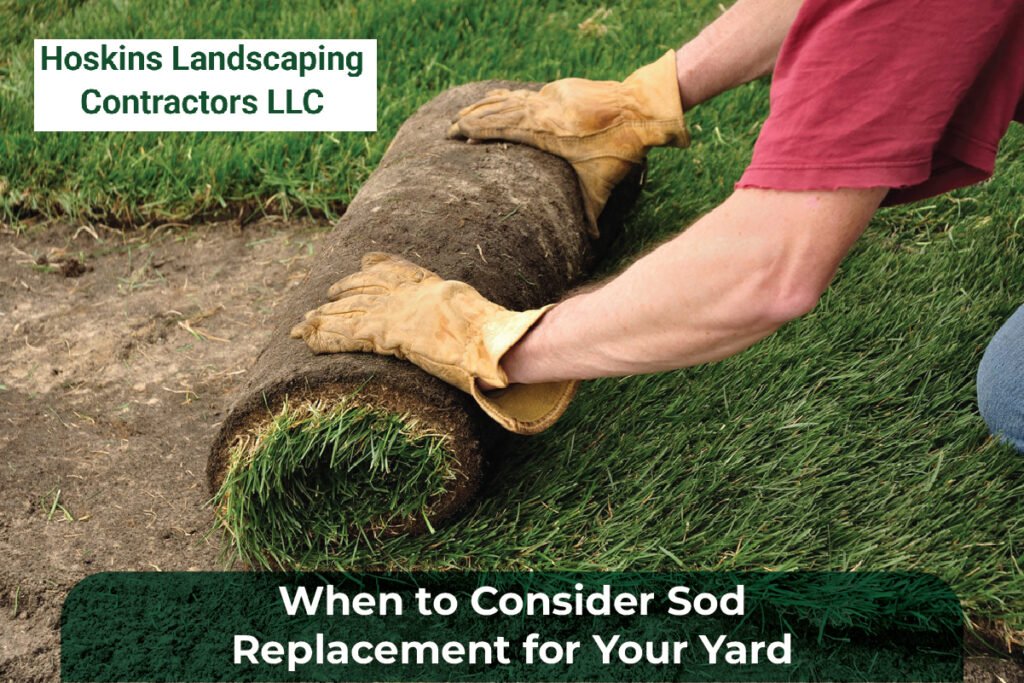Your lawn is more than just grass—it’s a key part of your home’s curb appeal and outdoor living space. But what happens when it starts to lose its charm, showing signs of wear, patchiness, or even bare spots? That’s when sod replacement becomes more than a landscaping option—it becomes a necessity.
In this guide, Hosking Landscaping & Contractors will explore when and why you should consider sod replacement, how it connects to related concepts like lawn restoration, grass patching, and resodding a lawn, and what steps to take for a successful transformation.
What is Sod Replacement?
Sod replacement is the process of removing existing grass and replacing it with freshly harvested sod—pre-grown grass rolls that establish quickly and offer an instant lush lawn. It’s a faster alternative to seeding and can rejuvenate your yard in days rather than weeks.
Signs You Need Sod Replacement
Knowing when to replace old grass is essential for lawn health and aesthetics. Here are the top signs your lawn may benefit from sod replacement:
1. Widespread Dead or Bare Patches
If more than 50% of your yard is covered in dead or bare areas, simple patching won’t do. Grass patching is ideal for isolated areas, but extensive damage requires a full turf replacement.
2. Persistent Weeds and Pests
Overrun by crabgrass, dandelions, or insects like grubs? A lawn heavily infested with weeds or pests can become too damaged for recovery. Lawn restoration through sod replacement allows you to start fresh with healthy, pest-free grass.
3. Poor Drainage and Soil Compaction
If your yard stays soggy after rainfall or feels hard underfoot, your soil may be compacted or poorly graded. When installing new sod, it’s a good opportunity to correct these underlying issues for long-term lawn health.
4. Fungal Diseases or Thatch Buildup
Persistent fungal issues or thick layers of thatch (dead organic material) can choke your lawn and make recovery nearly impossible. Lawn rejuvenation through sod replacement can eliminate these problems and give your yard a clean slate.
5. Outdated or Unattractive Grass Type
Not all grass types thrive in every climate or soil type. If your lawn never looks great no matter how much you care for it, the variety may not suit your region. Replacing old grass with a more appropriate sod type can make a big difference.
Benefits of Sod Replacement
Sod replacement offers several benefits that go beyond aesthetics:
- Instant results: No waiting for seeds to sprout.
- Erosion control: Helps stabilize soil quickly.
- Improved weed control: Healthy sod crowds out weeds.
- Increased property value: A lush lawn boosts curb appeal.
Sod Replacement vs Lawn Restoration
While both aim to improve your lawn, there’s a difference between lawn restoration and sod replacement:
- Lawn restoration typically involves aeration, overseeding, and fertilization to revive existing grass.
- Sod replacement removes the existing lawn entirely and lays down new sod.
If your current lawn is mostly healthy but sparse or thin, lawn rejuvenation methods may work. But if your yard is beyond saving, it’s time for a complete grass installation with sod.
The Sod Replacement Process
Step 1: Evaluate Your Lawn
Take note of areas with damage, waterlogging, or heavy thatch. Decide if a full replacement or partial resodding is needed.
Step 2: Remove the Old Grass
Use a sod cutter or shovel to remove the old turf. Ensure all roots and weeds are cleared to prevent regrowth.
Step 3: Prepare the Soil
Loosen the topsoil, level the surface, and mix in compost or topsoil as needed. Good prep ensures proper root establishment.
Step 4: Install New Sod
Lay sod pieces tightly together, staggering seams like brickwork. Roll the lawn to eliminate air pockets and help the sod adhere to the soil.
Step 5: Water and Maintain
Water thoroughly immediately after installation, then follow a strict watering schedule for the first few weeks. Avoid heavy foot traffic until the sod roots fully.
Best Time for Sod Replacement
The ideal time for sod installation depends on your grass type:
- Cool-season grasses: Early spring or fall
- Warm-season grasses: Late spring to early summer
Avoid peak summer heat or cold snaps, as extreme conditions stress new sod.
Cost Considerations
Sod replacement is more expensive than seeding, but the benefits often justify the investment:
- DIY Cost: $0.30–$0.85 per square foot
- Professional Installation: $1.50–$2.50+ per square foot
Factors like yard size, soil condition, and sod type affect the total price.
Final Thoughts
A struggling lawn doesn’t have to be a permanent problem. Whether your yard suffers from patchy grass, weeds, or poor soil, sod replacement can offer a dramatic transformation. By replacing old grass with healthy new sod, you’ll enjoy a vibrant lawn that boosts your home’s curb appeal and makes your outdoor space more inviting.
FAQs About Sod Replacement
Q1: How long does new sod take to root?
A: Typically, it takes about 2–3 weeks for sod to establish strong roots with proper watering and care.
Q2: Can I lay new sod over old grass?
A: No. Always remove existing grass and prep the soil before installing new sod for best results.
Q3: How often should I water new sod?
A: Water daily for the first 1–2 weeks, then gradually reduce to 2–3 times a week as the sod takes root.
Q4: Is sod replacement better than reseeding?
A: Sod offers quicker results and better weed control, while reseeding is more cost-effective but slower.
Q5: Can I walk on new sod?
A: Avoid walking on it for at least 2–3 weeks until it’s fully rooted to prevent damage.
